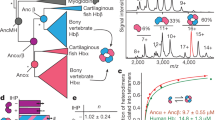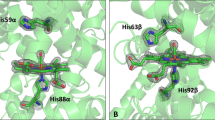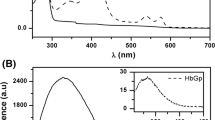Abstract
THE oligomeric protein haemerythrin is an oxygen-transport pigment found in erythrocytes of the coelomic fluid of certain invertebrates. It usually occurs as an octamer of molecular weight 108,000, in which each sub-unit contains two Fe atoms and reversibly binds one O2 molecule1. There is convincing evidence that myohaemerythrin, a monomeric protein found in the retractor muscles of the sipunculan worm Themiste pyroides, and the protomers of haemerythrin have quite similar tertiary structures2,3. Consequently, the low resolution structure obtained for myohaemerythrin4 has been used to solve the structure of octameric haemerythrin by molecular search techniques.
Similar content being viewed by others
References
Klotz, I. M., in Biological Macromolecules, 5, Subunits in Biological Systems (edit. by Timasheff, S. N., and Fasman, G. D.), 55–103 (Dekker, New York, 1971).
Klippenstein, G. L., VanRiper, D. A., and Oosterom, E. A., J. biol. Chem., 247, 5959–5963 (1972).
Hendrickson, W. A., and Klippenstein, G. L., J. molec. Biol., 87, 147–149 (1974).
Hendrickson, W. A., Klippenstein, G. L., and Ward, K. B., Proc. natn. Acad. Sci. U.S.A., 72, 2160–2164 (1975).
Stephen, A. C., and Edmonds, S. J., The Phyla Sipuncula and Echiura (British Museum (Natural History), London, 1972).
Klippenstein, G. L., Biochemistry, 11, 372–380 (1972).
Keresztes-Nagy, S., and Klotz, I. M., Biochemistry, 2, 923–927 (1963).
Matthews, B. W., J. molec. Biol., 33, 491–497 (1968).
North, A. C. T., and Stubbs, G. J., J. molec. Biol., 88, 125–131 (1974).
Loehr, J. S., Meyerhoff, K. N., Sieker, L. C., and Jensen, L. H., J. molec. Biol., 91, 521–522 (1975).
Crowther, R. A., in The Molecular Replacement Method (edit. by Rossmann, M. G.), 174–177 (Gordon and Breach, New York, 1972).
Crowther, R. A., and Blow, D. M., Acta crystallogr., 23, 544–548 (1967).
Matthews, B. W., and Bernhard, S. A., A. Rev. Biophys. Bioengng, 2, 257–317 (1973).
Hendrickson, W. A., and Ward, K. B., Biochem. biophys. Res. Commun. (in the press).
Rill, R. L., and Klotz, I. M., Archs Biochem. Biophys., 147, 226–241 (1971).
Fan, C. C., and York, J. L., Biochem. biophys. Res. Commun., 47, 472–476 (1972).
Klippenstein, G. L., Biochem. biophys. Res. Commun., 49, 1474–1479 (1972).
Fan, C. C., and York, J. L., Biochem. biophys. Res. Commun., 36, 365–372 (1969).
Morrissey, J. A., thesis, Univ. New Hampshire (1971).
Ferrell, R. E., and Kitto, G. B., Biochemistry, 10, 2923–2929 (1971).
Stenkamp, R. E., Sieker, L. C., Jensen, L. H., and Loehr, J. S., J. molec. Biol. (in the press).
Author information
Authors and Affiliations
Rights and permissions
About this article
Cite this article
WARD, K., HENDRICKSON, W. & KLIPPENSTEIN, G. Quaternary and tertiary structure of haemerythrin. Nature 257, 818–821 (1975). https://doi.org/10.1038/257818a0
Received:
Accepted:
Issue Date:
DOI: https://doi.org/10.1038/257818a0
- Springer Nature Limited
This article is cited by
-
Discovery and evolution of novel hemerythrin genes in annelid worms
BMC Evolutionary Biology (2017)
-
Molecular Evolution and Phylogeny of Sipunculan Hemerythrins
Journal of Molecular Evolution (2006)
-
Motifs involved in protein-protein interactions
Molecular Biology Reports (1993)
-
Sequence and structural relationships in the cytokine family
Journal of Protein Chemistry (1992)





